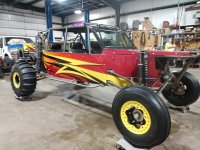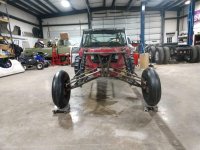Navigation
Install the app
How to install the app on iOS
Follow along with the video below to see how to install our site as a web app on your home screen.
Note: This feature may not be available in some browsers.
More options
Style variation
You are using an out of date browser. It may not display this or other websites correctly.
You should upgrade or use an alternative browser.
You should upgrade or use an alternative browser.
Front A-arm suspension setup
- Thread starter kgwmu
- Start date
Looney Duner
Well-known member
- May 9, 2021
- 604
- 499
Are you asking about camber, caster and Toe?
I run 1/8" toe, 0* camber, and 5* caster.
Also, I would lower the car.
I run 1/8" toe, 0* camber, and 5* caster.
Also, I would lower the car.
Rockwood
Well-known member
- May 5, 2021
- 6,241
- 8,038
Are you asking about camber, caster and Toe?
I run 1/8" toe, 0* camber, and 5* caster.
Also, I would lower the car.
x2, except 7* unless you don’t have PS. :biggrin:
Lower it so it has at least 33% droop available. Rides like sheeyit otherwise.
Fullthrottleguy
Site Sponsor
- May 5, 2021
- 1,104
- 1,487
With all honesty you are talking about doing an alignment on your car. Adjusting it incorrectly can be dangerous and cause the car to handle irrationally.
Having basic knowledge of Toe, Caster and camber is the place to start
Once you understand the basics and how to measure, how to adjust the Heim (rod ends) we be obvious, although you will need patiences, tools and doing it with a friend will make it easier - 4 hands are better
The rod ends are used just make it easier to adjust the overall aligment and quite franky make it easy to adjust for "non factory built" cars that may be a little loose of dimensional perfection... All these cars are hand made and sometimes questionable on the geometry to start with ..
For the most part the only thing to remember that seems strange to most people is that the Rod ends on the tie rods are left and right hand threads so they adsjust easiert without removing the tie rod - that freaks newbies out.
But before you start touching antything - you should ask yourself 3 things
1. Did I inspect everything? no cracks, bends, or other problems
2. Is the car going straight, handling ok? if so why should I touch it?
3. Am I prepared to make to the car worse or dangerous?
I would start here:
John has good write up
http://www.outfrontmotorsports.com/front_ends_101.htm
this is also a good read
https://www.valleyhutchinson.com/static/dealer-18845/pdfs/Wheel_Alignment.pdf
Once you understand the basics, this is a good general alignment guide using basic tools - they actually get it right:
https://blog.1aauto.com/diy-wheel-alignment-how-to-align-your-car-at-home-by-yourself/?gclid=Cj0KCQiA3-yQBhD3ARIsAHuHT64Gnz64eXCnAZyP8qMZzDHu57eZM2wuuYLPu_nefv1NuRdDQ5ghXi8aAuxXEALw_wcB
Having basic knowledge of Toe, Caster and camber is the place to start
Once you understand the basics and how to measure, how to adjust the Heim (rod ends) we be obvious, although you will need patiences, tools and doing it with a friend will make it easier - 4 hands are better
The rod ends are used just make it easier to adjust the overall aligment and quite franky make it easy to adjust for "non factory built" cars that may be a little loose of dimensional perfection... All these cars are hand made and sometimes questionable on the geometry to start with ..
For the most part the only thing to remember that seems strange to most people is that the Rod ends on the tie rods are left and right hand threads so they adsjust easiert without removing the tie rod - that freaks newbies out.
But before you start touching antything - you should ask yourself 3 things
1. Did I inspect everything? no cracks, bends, or other problems
2. Is the car going straight, handling ok? if so why should I touch it?
3. Am I prepared to make to the car worse or dangerous?
I would start here:
John has good write up
http://www.outfrontmotorsports.com/front_ends_101.htm
this is also a good read
https://www.valleyhutchinson.com/static/dealer-18845/pdfs/Wheel_Alignment.pdf
Once you understand the basics, this is a good general alignment guide using basic tools - they actually get it right:
https://blog.1aauto.com/diy-wheel-alignment-how-to-align-your-car-at-home-by-yourself/?gclid=Cj0KCQiA3-yQBhD3ARIsAHuHT64Gnz64eXCnAZyP8qMZzDHu57eZM2wuuYLPu_nefv1NuRdDQ5ghXi8aAuxXEALw_wcB
Last edited by a moderator:
Jtmoney714
Well-known member
- May 6, 2021
- 946
- 836
What would be the the best practice for measuring caster on a sand car?
Rockwood
Well-known member
- May 5, 2021
- 6,241
- 8,038
Find a flat surface parallel to a line through the middle of the upper and lower uniballs/heims and put an angle finder on it. You can also measure camber after turning lock to lock, but math required and I know you hate math :biggrin:What would be the the best practice for measuring caster on a sand car?
You can also bend a piece of flat stock into a U with equal length legs to touch the sides of the heims if nothing is parallel, then measure off of that.
Fullthrottleguy
Site Sponsor
- May 5, 2021
- 1,104
- 1,487
Like @Rockwood said caster and actually all alignment measurements are dynamic although they all should not be if the geometry is correct - on sand cars its mostly not and that is due to extreme travel and just bad math ... and none of the SxS's currently out these are much better (speed is still a mystery but I am assuming its gonna be pretty good). Thats why you hear so much about bump steer and cars that get out of control on the whoops. Whats more important IMO about caster is the measurement - you should have between 8-10 degrees positive to make the car track straight, improve high speed stability and help the car not pull the wheel out of your hands as you turn hard and deep sand. Of course none of that matters if the builder screwed up the ackerman ...
Also you are likely to see all your alignment change if you screw with the ride height of the car.
Before i mess with a Car I measure everything up - pull the shocks and run the suspension through a full cycle and make sure nothing binds, then I measure the toe change and the Camber change as I cycle the suspension (just cycle from full droop on shock length to full compression on shock length - that will also tell you the "usable travel" is, and thats usually different that full travel on non "brand name" cars). In theory that should not change, in practical application you could see toe change 1-2 even 3" and I have seen cars with significant camber changes - like top of wheel tilted in 2 degrees at ride height and tilted out 10 degrees at full compression (thats bad By The Way). That kinda stuff you cannot fix with alignment, and it will drive you cxrazy trying, that usually takes math, welding and fabrication (been there
Also you are likely to see all your alignment change if you screw with the ride height of the car.
Before i mess with a Car I measure everything up - pull the shocks and run the suspension through a full cycle and make sure nothing binds, then I measure the toe change and the Camber change as I cycle the suspension (just cycle from full droop on shock length to full compression on shock length - that will also tell you the "usable travel" is, and thats usually different that full travel on non "brand name" cars). In theory that should not change, in practical application you could see toe change 1-2 even 3" and I have seen cars with significant camber changes - like top of wheel tilted in 2 degrees at ride height and tilted out 10 degrees at full compression (thats bad By The Way). That kinda stuff you cannot fix with alignment, and it will drive you cxrazy trying, that usually takes math, welding and fabrication (been there
Last edited by a moderator:
- Thread starter
- #9
Are you asking about camber, caster and Toe?
I run 1/8" toe, 0* camber, and 5* caster.
Also, I would lower the car.
@Looney Duner @Rockwood, I was looking for all that info. This gives me a baseline to compare the current setup to. Our last car was much smaller and had center mount a-arms with bushings, so there was a lot less adjustments.x2, except 7* unless you don’t have PS. :biggrin:
Lower it so it has at least 33% droop available. Rides like sheeyit otherwise.
I knew the front spring rates were too stiff, so I already got the front lowered down. This still needs more adjustment, but I can at least read the spring rates now, others were painted over. I learned a lot about spring rates from you guys on my last car, so I'm shooting towards that 30-33% droop. Only thing I can't remember, do you guys measure that with or without passengers?
@Fullthrottleguy - We got this car last summer and I didn't have a chance to get it out, so I don't know how it handled/rode before. I understand the basics of chamber/caster/toe, so I'm not going at this completely blind, but I will be reading through the links you shared. I can also appreciate the point about making the car worse handling/dangerous.
As I go over the car getting it ready for our season here in MI, I'm trying to learn as much as I can. I figured with the amount of knowledge on this site, you guys would point me in the right direction. Thanks!
Last edited by a moderator:
Rockwood
Well-known member
- May 5, 2021
- 6,241
- 8,038
As commonly loaded, so if it's usually 2 fluffy fellers and a 12 pack, load it in. :biggrin:@Looney Duner @Rockwood, I was looking for all that info. This gives me a baseline to compare the current setup to. Our last car was much smaller and had center mount a-arms with bushings, so there was a lot less adjustments.
I knew the front spring rates were too stiff, so I already got the front lowered down. This still needs more adjustment, but I can at least read the spring rates now, others were painted over. I learned a lot about spring rates from you guys on my last car, so I'm shooting towards that 30-33% droop. Only thing I can't remember, do you guys measure that with or without passengers?
@Fullthrottleguy - We got this car last summer and I didn't have a chance to get it out, so I don't know how it handled/rode before. I understand the basics of chamber/caster/toe, so I'm not going at this completely blind, but I will be reading through the links you shared. I can also appreciate the point about making the car worse handling/dangerous.
As I go over the car getting it ready for our season here in MI, I'm trying to learn as much as I can. I figured with the amount of knowledge on this site, you guys would point me in the right direction. Thanks!
Kat-A-Tonic
Well-known member
- May 6, 2021
- 606
- 835
My car has similar front suspension to yours. One thing you need to be aware of is that you cant really adjust one of the inside heims on the a-arms much without adjusting the other inner as well. It will suddenly not fit the tabs on the car. It should not require a prybar to get the bolts back through the heims.



